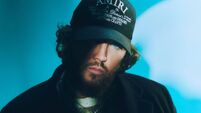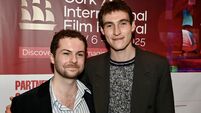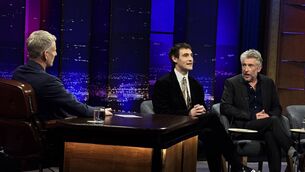John Minihan on photographing Edna O’Brien: 'Everyone wanted to meet her'

Edna O'Brien: photographed by John Minihan (right)
Edna O’Brien’s was one of the best-known faces in the London of the Swinging Sixties.
Beautiful and glamorous, O’Brien commanded attention, and featured regularly in the social columns in the newspapers. But she had come by fame the hard way, by dint of her achievements. By 1968, when the Irish photographer John Minihan first met her, at a Foyle’s Literary Lunch, she had already published five novels, including the Country Girls trilogy.
“Foyle’s was the biggest bookshop in London at that time,” says Minihan, “and their literary lunches were always a big event. Edna had a new book out, and everyone wanted to meet her. I remember she was really charming.”
By then, she’d already divorced her husband, Ernest Gebler, and won custody of their two sons, Carlo and Sasha. For a time, she was successful enough that they could live in a degree of luxury. “By the early 1970s, Edna had a beautiful house in Carlyle Square, off King’s Road in Chelsea. She loved living there. She lost the place later, which was a shame, but that’s another story.”
The house in Carlyle Square was where Minihan took what is arguably the most famous photograph of O’Brien, in 1971. Dressed to the nines, with strings of pearls around her neck, she sits in the window, with one foot on the windowsill, staring fearlessly into the camera. She looks so like a movie star that one might presume she’d spent hours with make-up and wardrobe assistants preparing for the shoot.
But that was not the case at all; Minihan remembers that she had answered the door in the same attire, and the shoot was entirely spontaneous. “Edna had asked me round for tea and scones,” he says. “And after half an hour or so, I asked if I could take a picture.”

Minihan photographed O’Brien on dozens of occasions after that, sometimes alone, and sometimes in the company of friends such as the playwright Harold Pinter and his wife, the historian Antonia Fraser.
She was a loyal friend. Minihan remembers that when the Royal Court Theatre staged her play, A Pagan Place, in 1972, the director, Oscar Lowenstein, invited him to show his photographs front of house. “I was delighted when Edna and Luke Kelly both came to the opening,” he says.
Minihan chose to exhibit a series of photographs he’d taken of friends and neighbours in his native Athy, Co Kildare, a remarkable project that soon caught the eye of the prestigious Sunday Times critic, Harold Hobson. “The PR woman at the Royal Court told me I should buy that week’s Sunday Times. And sure enough, Harold had reviewed my exhibition, saying my photographs were ‘poignant, sad and sublime.’”
Minihan’s Athy photographs, which included images of the funeral of a woman named Katy Tyrrell, won him an audience with the reclusive Samuel Beckett when he visited London to direct his play Endgame in Hammersmith in 1980. Beckett greatly admired the photographs, and allowed Minihan to photograph him in his room at the Hyde Park Hotel.
Minihan and O’Brien were both huge admirers of Beckett’s work. “Edna had her wars with the Church and State in Ireland,” says Minihan. “Her books were banned for a long time. But she was very excited to be on the same list of banned books as Beckett was, for his short story collection, More Pricks Than Kicks.”
Beckett’s UK publisher was John Calder, who threw extravagant parties at his apartment in Soho in the 1970s and ’80s. “Edna was at one of those parties, and Beckett was tinkling the keys on the Bechstein piano,” says Minihan. “I wasn’t there, but I heard that she leaned over the piano, gazed into Beckett’s eyes, and said: ‘Play it again, Sam!’”
O’Brien and Beckett became friends, and a few years later, when she heard that Beckett had invited Minihan to Paris to photograph him once more, she rang to ask a favour. “I nearly always work in black and white, but she asked me to photograph Beckett in colour, as he had what she described as the most amazing blue eyes. And it was true; they were extraordinary, a turquoise blue, like a Native American Indian’s. I took that colour photograph of Beckett in Montmartre for Edna.”
Minihan moved back to Ireland in 1996. “But Edna came and went, and we always stayed in touch.” In 2014, Van Morrison asked Minihan to photograph a series of concerts in London, Belfast and Dublin. “In the first half of the show, he’d invited writers to read his lyrics. People like Michael Longley, and Gerald Dawe, who we lost lately. And Edna, of course. She read the lyrics to Madame George.
“I took a wonderful photo of Edna and Van in the dressing room after the show, just the two of them holding a copy of the album Astral Weeks. The spotlight was shining on the album, and you could see the wine stains on the cover.“
A few years later, O’Brien was honoured at a function at the Gaiety Theatre in Dublin. “Edna was staying at the Merrion Hotel,” says Minihan, “and again, she asked me round for tea. On that occasion, I photographed her holding the photo I’d taken in Carlyle Square in 1971.”
The last time Minihan photographed O’Brien was at Listowel Writers Week in 2018, when she was awarded the John B Keane Lifetime Achievement Award, in association with Mercier Press. “I was in Listowel for two or three days,” he says. “Edna was staying at the Listowel Arms, and she asked me to take a photo. Her son Carlo was there as well. I photographed Edna on her own, and again with Carlo.”
Minihan is now based in Skibbereen, Co Cork, and is preparing an exhibition of his work for the Riverside Café in September. His photographs of O’Brien will no doubt be a highlight. Five decades after they first met, he remembers the author with great affection.
“She was a good egg,” he says. “Always very gracious and lovely.”




